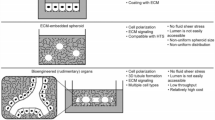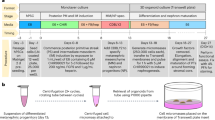Abstract
Sodium-potassium adenosine triphosphatase (Na-K-ATPase) activity was measured by microassay, and the surface density of basolateral membranes was measured morphometrically in postglomerular segments of single tubules isolated from normally developing, intact mouse kidneys and from transfilter metanephric cultures. Proximal tubule Na-K-ATPase activity was 1092±480 pmol/mm per hour in newborn mice, increasing to 2462±258 in 1-week-old and 3470–578 pmol/mm per hour in adult mice. The Na-K-ATPase activity in newborn mice was approximately one-third of the activity in adult mice. Tubular Na-K-ATPase in transfilter metanephric culture was 972±536 pmol/mm per hour, a mean value almost identical to that in newborn mice. The surface density of basolateral cell membranes was 1.36±0.60 μm2/μm3 in newborn mice and 1.34±0.45 μm2/μm3 in 1-week-old mice, increasing to 2.70±0.98 μm2/μm3 in 4-week-old mice and 2.89±0.51 μm2/μm3 in adult mice. The surface density of tubular basolateral cell membranes in transfilter metanephric culture was 1.13±0.51 μm2/μm3, not significantly different from the surface density in newborn mice. The calculated mean surface area of basolateral membranes per unit tubular length was greater in cultures than in newborns, however, because total epithelial volume per unit length was significantly larger in the cultured tubules. Membrane surface area in intact mice increased with age, the surface area per unit length of tubule in adults being 4.6 times the area in newborn animals. The ratio of enzyme activity to membrane surface area more than doubled in the 1st week of life without any increase in the density or surface area of basolateral membranes. The ratio fell thereafter, as membrane area increased with maturation, to a value in the adult animal three-fourths of that in the newborn. The early postnatal increase in enzyme activity, beginning almost immediately after birth, possibly relates to an increased density of enzyme sites on the membrane. The postnatal spurt in enzyme activity, without a corresponding increase in membrane area, suggests that tubules have considerable functional reserve in generating a complement of sodium pumps. The studies of proximal tubules grown in metanephric culture show that the basolateral membranes and the sodium pump are initiated independently of renal blood flow and tubular fluid flow, presumably as inherent characteristics. The functional data confirm the similarity, already shown by morphometric studies, between natural tubules and those grown in culture.
Similar content being viewed by others
References
Jørgensen PL (1980) Sodium and potassium ion pump in kidney tubules. Physiol Rev 60: 864–917
Sachs G (1977) Ion pumps in the renal tubule. Am J Physiol 233:F359-F365
Doucet A (1985) Na-K-ATPase: General considerations, role and regulation in the kidney. In: Grünfeld JP, Maxwell MH (eds) Advances in nephrology, vol 14. Year Book Medical Publishers, Chicago, p 87
Katz AI (1982) Renal Na-K-ATPase: its role in tubular sodium and potassium transport. Am J Physiol 242: F207-F219
Kyte J (1976) Immunoferritin determination of the distribution of (Na++K+) ATPase over the plasma membranes of renal convoluted tubules II. Proximal segment. J Cell Biol 68: 304–318
Rostgaard J, Møller O (1980) Localization of Na+, K+-ATPase to the inside of the basolateral cell membranes of epithelial cells of proximal and distal tubules in rabbit kidney. Cell Tissue Res 212: 17–28
Goldin SM (1977) Active transport of sodium and potassium ions by the sodium and potassium ion-activated adenosine triphosphatase from renal medulla: Reconstitution of the purified enzyme into a well defined in vitro transport system. J Biol Chem 252: 5630–5642
Katz AI, Doucet A, Morel F (1979) Na-K-ATPase activity along the rabbit, rat and mouse nephron. Am J Physiol 237: F114-F120
Aperia A, Larsson L (1979) Correlation between fluid reabsorption and proximal tubule ultrastructure during development of the rat kidney. Acta Physiol Scand 105: 11–22
Aperia A, Larsson L (1984) Induced development of proximal tubular NaKATPase, basolateral cell membranes and fluid resorption. Acta Physiol Scand 121: 133–141
Dobrovic-Jenik D, Ozegovic B, Milkovic S (1984) Postnatal development of rat kidney plasma membrane Na-K-ATPase. Biol Neonate 46: 115–121
Evan AP, Gattone VH II, Schwartz GJ (1983) Development of solute transport in rabbit proximal tubule. II. Morphologic segmentation. Am J Physiol 245: F391-F407
Larsson L, Horster M (1976) Ultrastructure and net fluid transport in isolated perfused developing proximal tubules. J Ultrastruct Res 54: 276–285
Schmidt U, Horster M (1977) Na-K-activated ATPase: activity maturation in rabbit nephron segments dissected in vitro. Am J Physiol 233: F55-F60
Schwartz GJ, Evan AP (1984) Development of solute transport in rabbit proximal tubule. III. Na-K-ATPase activity. Am J Physiol 246: F845-F852
Garg LC, Narang N, Wingo CS (1985) Glucocorticoid effects on Na-ATPase in rabbit nephron segments. Am J Physiol 248: F487-F491
Lameire NH, Lifschitz MD, Stein JH (1977) Heterogeneity of nephron function. Annu Rev Physiol 39: 159–184
Schmidt U, Dubach UC (1969) Differential enzymatic behavior of single proximal segments of the superficial and juxtamedullary nephron. I. Alkaline phosphatase, (Mg++) ATPase and (Na+K+)ATPase. Z. Ges Exp Med 151: 93–102
Valtin H (1977) Structural and functional heterogeneity of mammalian nephrons. Am J Physiol 233: F491-F501
Furuse A, Bernstein J, Welling LW, Welling DJ (1989) Renal tubular differentiation in metanephric culture. I. Ultrastructural studies. Ped Nephrol 3: 265–272
Linshaw MA, Bauman CA, Welling LW (1986) Use of trypan blue for identifying early proximal convoluted tubules. Am J Physiol 251: F214-F219
Bernstein J, Cheng F, Roszka J (1981) Glomerular differentiation in metanephric culture. Lab Invest 45: 183–190
Burg M, Grantham, J, Abramow M, Orloff J (1966) Preparation and study of fragments of single rabbit nephrons. Am J Physiol 210: 1293–1298
Chonko AM, Irish JM III, Welling DJ (1978) Microperfusion of isolated tubules, Chap. 9, In: Martinez-Maldonado M (ed) Methods in pharmacology, vol 4B. Plenum Publishing, New York, pp 236–239
Linshaw MA, Welling LW (1983) Basolateral membrane properties in proximal convoluted tubules of the newborn rabbit. Am J Physiol 244: F172-F177
Doucet A, Katz AI, Morel F (1979) Determination of Na−K-ATPase activity in single segments of the mammalian nephron. Am J Physiol 237: F105-F113
Weibel ER, Kistler GS, Scherle WF (1966) Practical stereological methods for morphometric cytology. J Cell Biol 30:23–38
Bernstein J (1978) Morphologic development of the metanephric tubule. In: Proceedings of the 7th International Congress of Nephrology, Montreal. Karger, Basel pp 249–254
Ekblom P, Miettinen A, Saxén L (1980) Induction of brush border antigens of the proximal tubule in the development kidney. Dev Biol 74:263–274
Ekblom P, Miettinen A, Virtanen I, Wahlström T, Dawnay A, Saxén L (1981) In vitro segregation of the metanephric nephron. Dev Biol 84: 88–95
Grobstein C (1956) Trans-filter induction of tubules in mouse metanephric mesenchyme. Exp Cell Res 10: 424–440
Avner ED, Sweeney WE, Finegold DN, Piesco NP, Ellis D (1985) Sodium-potassium ATPase activity mediates cyst formation in metanephric organ culture. Kidney Int 28:447–455
O'Neil RG, Dubinsky WP (1984) Micromethodology for measuring ATPase activity in renal tubules: mineralocorticoid influence. Am J Physiol 247: C314-C320
Schwartz GJ, Lin JT, Kinne R (1983) A kinetic assay for Na−K-ATPase activity in isolated renal proximal tubules. Anal Biochem 129: 210–215
Author information
Authors and Affiliations
Rights and permissions
About this article
Cite this article
Furuse, A., Bernstein, J., Welling, L.W. et al. Renal tubular differentiation in mouse and mouse metanephric culture. Pediatr Nephrol 3, 273–279 (1989). https://doi.org/10.1007/BF00858528
Received:
Revised:
Accepted:
Issue Date:
DOI: https://doi.org/10.1007/BF00858528




